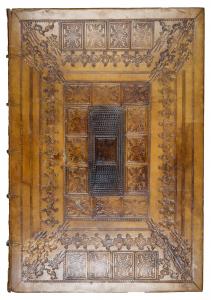Flore Portugaise ou description de toutes les plantes qui croissent naturellement en Portugal.
Eur 7,500 / USD 8,600
The price shown on each item does not include V.A.T (Value Added Tax). As a result of the recent EU legislation we are required to charge our EU customers the percentage of V.A.T. charged by the customer’s country of residence, unless they possess a V.A.T. registration number. Postage Additional.
Berlin, Charles Fréderic Amelang for the authors, 1809-1820 (-1840). Folio (485 x 335mm, 2 text vols & 525 x 355mm, atlas). 22 parts bound in 3 volumes. With 1 lithographed title (a garland of flowers), 3 uncoloured plates of instructions and 100 (of 111) plates, 98 of them stipple-engravings of which 93 printed in colours and finished by hand, and two (nos. 20 and 22) coloured lithographs, engraved by Bollinger, Clar, Dumbte, Guimpel, Haas, Krethlow, Meyer, Schubert and Wachmann after drawings by G.W. Voelker and Hoffmansegg, French and Latin text. Recent blind pressed calf, spines in 6 compartments.
It was produced by Count Hoffmannsegg, contemporary of Redouté, whose work it rivals
One of the most complete copies to come on the market. It lacks 11 plates but has more text than the Kenneth K.Mackenzie, Horticultural Society of New York, Robert de Belder copy (Christie's New York 4 June 1997), which was the most complete copy to come on the market since decades.
Only edition of this rare work, the technical and artistic equal of any of the 19th century flower books, and a work that has escaped the notice of historians of botanical illustration. It was produced by Count Hoffmannsegg, contemporary of Redouté, whose work it rivals. In our opinion it surpasses the latter's 'Jardin de la Malmaison', perhaps technically the finest of Redouté's oeuvres. The preface confidently predicts 'we are certain that, despite the fact that this will be the first such work to be published in Germany, it will bear comparison with other floras, and even with all similar works published to this day', a boast that it more than fulfils. All plates illustrate species newly discovered and previously undescribed, drawn from living specimens by Hoffmannsegg or from his herbarium specimens by Voelker. In the present copy plates 66, 103, 104, 105, 106 are plain. The following plates are not present in our copy: 24, 26, 65, 68, 74, 75, 77, 83, 98, 99 and 101. The text of the second volume is so rare that Stafleu leaves open the collation of parts 17-21. In our copy only 8 text leaves are not inserted, which makes it text wise one of the most complete copies. The atlas had the printed wrapper bound in of the 6th part, a printed title to the plates was not published. Pages 437-504 loosely inserted.
Dunthorne 136; Great Flower Books p. 59; Nissen BBI, 901; Stafleu & Cowan 2911.














